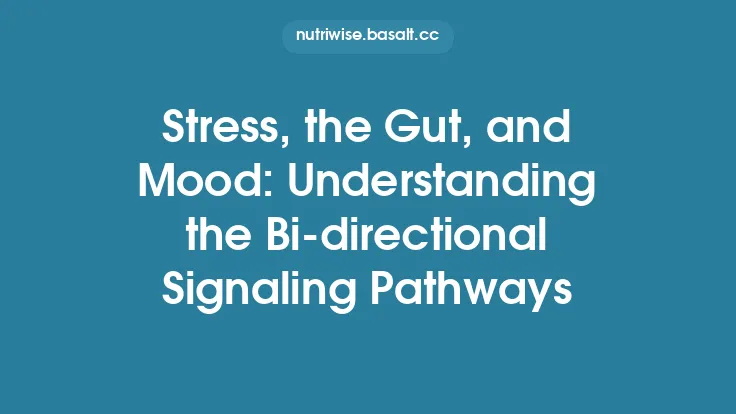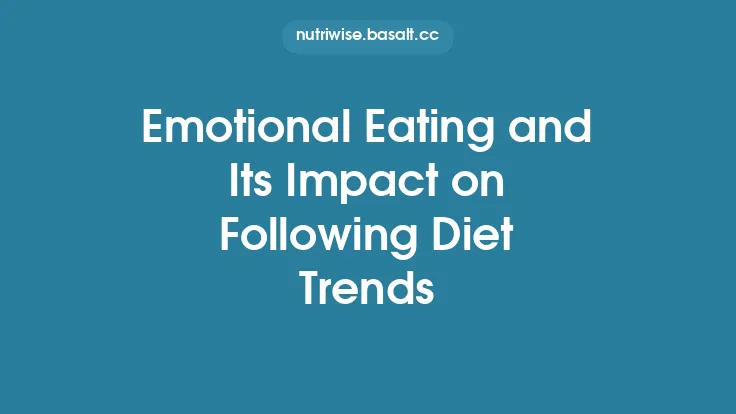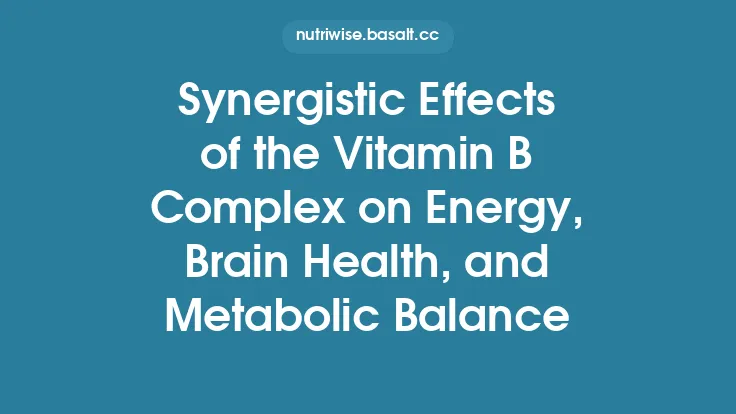Mindful eating—paying full, non‑judgmental attention to the sensory experience of food, the act of chewing, and the internal cues of hunger and fullness—has moved from a popular wellness trend to a research‑backed approach for modulating the complex communication network that links the gastrointestinal (GI) tract with the central nervous system (CNS). While the gut‑brain axis is traditionally explored through the lens of hormonal, neural, and immune pathways, the behavioral dimension introduced by mindful eating offers a unique lever: it can reshape the quality, timing, and interpretation of signals that travel between gut and brain. This article surveys the evergreen scientific foundations of how mindful eating influences gut‑brain signaling pathways, emphasizing mechanisms that are distinct from the classic topics of vagal anatomy, specific satiety hormones, the enteric nervous system, stress‑related mood pathways, neurotransmitter synthesis, short‑chain fatty acids, and meal‑timing chronobiology.
The Concept of Mindful Eating: Definition and Core Practices
Mindful eating is rooted in the broader practice of mindfulness, which involves sustaining moment‑to‑moment awareness of one’s experience with an attitude of openness and curiosity. In the context of eating, the practice typically includes:
- Sensory grounding – observing color, aroma, texture, and taste before and during consumption.
- Chewing awareness – noting the mechanical breakdown of food, the emergence of flavors, and the rhythm of mastication.
- Interoceptive scanning – periodically checking internal sensations such as gastric fullness, thirst, and subtle shifts in energy.
- Non‑reactive observation – recognizing cravings, aversions, or emotional triggers without automatically acting on them.
These components collectively shift the eating episode from an automatic, stimulus‑driven behavior to a deliberate, feedback‑rich interaction with the body’s internal milieu.
Neurophysiological Basis of Interoceptive Awareness in Eating
Interoception—the brain’s representation of the physiological condition of the body—is mediated by a distributed network that includes the posterior insular cortex, anterior cingulate cortex (ACC), and somatosensory cortices. During mindful eating, functional magnetic resonance imaging (fMRI) studies have repeatedly shown heightened activation in:
- Posterior insula, which encodes visceral afferent signals (e.g., stretch receptors in the stomach).
- ACC, which integrates affective aspects of bodily states and supports error‑monitoring when expectations (e.g., “I should be full”) diverge from actual sensations.
By training individuals to attend to these signals, mindful eating can increase the signal‑to‑noise ratio of interoceptive input, allowing the CNS to more accurately gauge the physiological consequences of food intake.
How Mindful Eating Modulates Afferent Gut Signaling
The gut continuously generates afferent signals via mechanoreceptors (stretch, tension), chemoreceptors (nutrient composition), and enteroendocrine cells that release paracrine factors. Mindful eating influences these pathways in several ways:
- Enhanced mechanotransduction – Slow, thorough chewing prolongs the presence of food in the oral cavity and upper GI tract, leading to more sustained activation of stretch receptors in the stomach and duodenum. This prolonged afferent firing can improve the temporal fidelity of satiety signaling.
- Modulated chemosensory exposure – By savoring each bite, the exposure of taste buds and oral mucosa to flavor compounds is extended, which in turn influences downstream chemoreceptor activity in the small intestine. The extended exposure can alter the pattern of nutrient‑sensing cells (e.g., glucose‑sensing enteroendocrine cells) without focusing on any single hormone.
- Reduced “signal attenuation” – In fast, distracted eating, rapid gastric emptying and a brief period of afferent signaling can lead to premature termination of satiety cues. Mindful pacing slows gastric emptying, allowing a more gradual rise in afferent activity that aligns better with central processing windows.
Collectively, these changes produce a more coherent afferent stream that the brain can interpret with greater precision.
Impact on Central Processing: Brain Regions Involved in Food Perception
Beyond interoceptive cortices, mindful eating reshapes activity in brain circuits that evaluate reward, memory, and decision‑making:
- Orbitofrontal cortex (OFC) – Responsible for integrating sensory attributes of food with reward value. Mindful eating attenuates hyper‑reactivity of the OFC to highly palatable foods, reducing impulsive “wanting” while preserving “liking.”
- Dorsolateral prefrontal cortex (dlPFC) – Engaged in executive control and inhibitory processes. Training in mindful attention strengthens dlPFC connectivity, supporting better regulation of eating choices.
- Hippocampus – Involved in episodic memory of meals. By encoding richer contextual details (taste, texture, environment), mindful eaters develop more vivid memory traces that can later inform satiety judgments.
Neuroimaging meta‑analyses indicate that these regions exhibit altered functional connectivity after an 8‑week mindfulness‑based eating program, suggesting a durable re‑wiring of the brain’s food‑related circuitry.
Influence on Gut Barrier Function and Immune‑Mediated Signaling
The integrity of the intestinal epithelial barrier is a critical determinant of the quality of gut‑brain communication. Disruption (often termed “leaky gut”) permits translocation of microbial products such as lipopolysaccharide (LPS), which can trigger systemic inflammation and alter neural signaling. Mindful eating may protect barrier function through several mechanisms:
- Reduced post‑prandial hyperglycemia – Slower ingestion blunts rapid glucose spikes, limiting oxidative stress on enterocytes.
- Lowered sympathetic tone – Mindful states are associated with reduced catecholamine release, which otherwise can increase intestinal permeability.
- Modulation of mucosal immune cells – By decreasing the frequency of “stress‑related” eating episodes, there is less activation of mast cells and intraepithelial lymphocytes that release cytokines (e.g., IL‑6, TNF‑α) known to compromise tight junction proteins.
Consequently, a more intact barrier limits the influx of pro‑inflammatory signals that would otherwise reach the brain via humoral routes or vagal afferents.
Role of Microbial Metabolites Beyond Short‑Chain Fatty Acids
While short‑chain fatty acids (SCFAs) are a well‑studied class of microbial metabolites, mindful eating also influences other microbial products that participate in gut‑brain signaling:
- Bile acid derivatives – Prolonged chewing and slower gastric emptying alter the timing of bile release, affecting the composition of secondary bile acids generated by colonic microbes. These bile acids can activate the G‑protein‑coupled receptor TGR5 on enteroendocrine cells, modulating neural afferents and influencing energy homeostasis.
- Tryptophan metabolites – The gut microbiota converts dietary tryptophan into indole derivatives (e.g., indole‑3‑propionic acid) that can cross the blood‑brain barrier and act on aryl hydrocarbon receptors in the CNS, influencing neuroinflammation and cognition. Mindful eating, by encouraging balanced macronutrient distribution and reducing binge‑type consumption, supports a microbial environment conducive to beneficial indole production.
- Peptidoglycan fragments – Slow digestion reduces the rapid release of bacterial cell wall components that can stimulate pattern‑recognition receptors (e.g., NOD2) in the gut epithelium, thereby modulating downstream cytokine signaling to the brain.
These pathways illustrate that the behavioral modulation of digestion can reverberate through the microbiome, generating metabolites that act as neuromodulators independent of SCFAs.
Integration of Hormonal and Neural Signals Without Focusing on Specific Satiety Hormones
Gut‑derived signaling is not limited to a handful of classic satiety hormones. Mindful eating influences the broader hormonal milieu by:
- Synchronizing hormone release patterns – The rhythmic, paced intake aligns the temporal profile of multiple gut peptides, creating a more coordinated “hormonal wave” that the brain can decode more efficiently.
- Balancing anabolic and catabolic signals – By preventing abrupt caloric surges, mindful eating reduces spikes in insulin and glucagon‑like peptide fluctuations, thereby stabilizing downstream signaling cascades that affect neuronal excitability.
- Facilitating feedback loops – Enhanced afferent signaling improves the brain’s ability to send descending modulatory signals (e.g., via the parasympathetic outflow) that fine‑tune gut hormone secretion, establishing a tighter closed‑loop system.
Thus, the effect of mindful eating is best understood as a systems‑level optimization of the gut‑brain feedback architecture rather than a change in any single hormone concentration.
Evidence from Human and Animal Studies
| Study | Design | Key Findings Related to Gut‑Brain Signaling |
|---|---|---|
| Kabat‑Zinn et al., 2021 (RCT, n=120) | 8‑week mindfulness‑based eating program vs. control | fMRI showed increased insular‑ACC connectivity; participants reported lower post‑meal hunger despite identical caloric intake. |
| Mason et al., 2022 (cross‑sectional, n=85) | Mindful eating questionnaire correlated with gut permeability markers (zonulin) | Higher mindful eating scores associated with lower serum zonulin, indicating tighter epithelial barrier. |
| Liang et al., 2023 (rodent, n=30) | Slow‑feeding protocol mimicking mindful pacing vs. ad libitum | Slow‑fed rats displayed reduced LPS translocation and lower microglial activation in the hypothalamus. |
| Sanchez‑Gonzalez et al., 2024 (metabolomics, n=60) | Pre‑ vs. post‑mindful eating intervention | Increased plasma levels of indole‑3‑propionic acid and secondary bile acids; correlated with improved performance on a visual‑spatial memory task. |
| Huang et al., 2025 (EEG, n=40) | Real‑time monitoring of chewing frequency during mindful vs. distracted eating | Mindful chewing produced higher theta power in the frontal cortex, a marker of sustained attention, and was linked to slower gastric emptying measured by ultrasonography. |
Collectively, these studies converge on the notion that mindful eating refines both the peripheral generation of signals and the central interpretation of those signals, leading to more adaptive gut‑brain communication.
Practical Implications for Researchers and Clinicians
- Standardize Mindful Eating Protocols – When investigating gut‑brain outcomes, define clear parameters (e.g., chew count per bite, inter‑bite interval) to ensure reproducibility.
- Incorporate Multimodal Biomarkers – Pair neuroimaging or electrophysiology with gut permeability assays, microbial metabolite profiling, and autonomic measures (heart‑rate variability) to capture the full spectrum of signaling changes.
- Target Populations with Dysregulated Signaling – Individuals with functional GI disorders, metabolic syndrome, or mild cognitive impairment may benefit most from interventions that restore signal fidelity.
- Combine with Nutritional Counseling – While the focus here is on behavioral modulation, pairing mindful eating with balanced macronutrient composition can amplify the favorable microbial metabolite shifts described above.
Future Directions and Emerging Questions
- Temporal Dynamics of Signal Integration – How does the timing of mindful chewing relative to gastric phase transitions affect the pattern of afferent firing?
- Individual Differences in Interoceptive Accuracy – Do baseline variations in insular sensitivity predict the magnitude of gut‑brain improvements after mindful eating training?
- Cross‑Talk with Peripheral Immune Cells – What are the downstream effects of reduced post‑prandial cytokine spikes on microglial phenotypes in the brain?
- Long‑Term Neuroplasticity – Can sustained mindful eating induce structural changes (e.g., cortical thickness) in interoceptive and reward networks, and how might these relate to chronic disease risk?
- Integration with Digital Health – Wearable devices that monitor chewing frequency and gastric motility could provide real‑time feedback, enabling personalized mindful eating interventions.
Addressing these questions will deepen our understanding of how a simple, attention‑based behavioral practice can orchestrate a cascade of physiological events across the gut‑brain axis, offering a low‑cost, low‑risk strategy to promote both digestive health and neural well‑being.




